Submitted:
06 May 2024
Posted:
08 May 2024
You are already at the latest version
Abstract
Keywords:
What is more I loved, and still do love, mathematics for itself as not allowing room for hypocrisy or vagueness, my two pet aversions.
Stendhal [1 (p. 111)].
1. Introduction
The famine became bad everywhere in Egypt, so Joseph opened the storehouses and sold the grain to the Egyptians. People from all over the world came to Egypt to buy grain, because the famine was so severe in their countries. (Καὶ ὁ λιμὸς ἦν ἐπὶ προσώπου πάσης τῆς γῆς· ἀνέῳξε δὲ Ἰωσὴφ πάντας τοὺς σιτοβολῶνας, καὶ ἐπώλει πᾶσι τοῖς Aἰγυπτίοις. Καὶ πᾶσαι αἱ χῶραι ἦλθον εἰς Aἴγυπτον, ἀγοράζειν πρὸς Ἰωσήφ· ἐπεκράτησε γὰρ ὁ λιμὸς ἐν πάσῃ τῇ γῇ).[5]
I was a man who protected the afflicted against the powerful […] who supplied the granaries of the god […] who summoned his entire energy every time he saw an insufficient flood.
I gave grain to the entire country, I saved my town from famine […] no one has done what I did.
2. Theoretical Analysis
2.1 System Components and Determination of Their Temporal Evolution
2.2 Residence Time
- Linear reservoir (in which ), any inflow:
- Superlinear benchmark reservoir, , constant inflow:
- Sublinear benchmark reservoir, , constant inflow:
2.3 Response Time
- Observation 1: For a linear reservoir, the mean residence time and the mean response time are equal to each other, with a value . The median residence time and the median response are also equal to each other and smaller than by a factor ln 2 = 0.69.
- Observation 2: For a sublinear reservoir, the mean and median response times are generally smaller than the mean and median residence time, respectively, and can only become equal if the input is zero.
- Observation 3: From a practical point of view and for a reservoir that is not superlinear, the response times are smaller than the characteristic value , and the residence times can only slightly (by < 10%) exceed this value (for highly sublinear reservoirs and initial inflow higher than outflow).
2.4 Parameters and their Estimation
3. Application to the Carbon Cycle
3.1 A Summary of the Established Approach
3.1.1 Improper Terminology, Obscureness, Ambiguity and Vagueness
- Lifetime is a general term used for various time scales characterizing the rate of processes affecting the concentration of trace gases. The following lifetimes may be distinguished:
- […] Response time or adjustment time (Ta) is the time scale characterizing the decay of an instantaneous pulse input into the reservoir. The term adjustment time is also used to characterize the adjustment of the mass of a reservoir following a step change in the source strength. Half-life or decay constant is used to quantify a first-order exponential decay process. […]
- The term lifetime is sometimes used, for simplicity, as a surrogate for adjustment time.
- In simple cases, where the global removal of the compound is directly proportional to the total mass of the reservoir, the adjustment time equals the turnover time: T = Ta.
- […]
- Turnover time (T) (also called global atmospheric lifetime) is the ratio of the mass M of a reservoir (e.g., a gaseous compound in the atmosphere) and the total rate of removal S from the reservoir: T = M/S.
- […]
- Response time or adjustment time In the context of climate variations, the response time or adjustment time is the time needed for the climate system or its components to re-equilibrate to a new state, following a forcing resulting from external processes. It is very different for various components of the climate system. The response time of the troposphere is relatively short, from days to weeks, whereas the stratosphere reaches equilibrium on a time scale of typically a few months. […] In the context of lifetimes, response time or adjustment time (Ta) is the time scale characterizing the decay of an instantaneous pulse input into the reservoir.
3.1.2 Separate Treatment of CO₂ Depending on its Origin
3.1.2 Inappropriate Modelling and Inconsistent Results
3.2 Data
- From mass of C to mass of CO₂, we multiply by 44/12 = 3.67 kg CO₂ / kg C (where 44 and 12 are the molecular masses of CO₂ and C);
- From atmospheric CO₂ concentration in ppm to total atmospheric mass in Gt CO₂ we multiply by 7.8 Gt CO₂ / ppm CO₂.
3.3 Premises of the Application
- Human activities are responsible for only 4% of carbon emissions.
- The vast majority of changes in the atmosphere since 1750 (red bars in the graph) are due to natural processes, respiration and photosynthesis.
- The increases of both CO₂ emissions and sinks are due to the temperature increase, which expands the biosphere and makes it more productive.
- The terrestrial biosphere processes are much stronger than the maritime ones in terms of both production and absorption of CO₂.
- The CO₂ emissions by merely the ocean biosphere are much larger than human emissions.
- The modern (post 1750) CO₂ additions to pre-industrial quantities (red bars in the right half of the graph, corresponding to positive values) exceed the human emissions by a factor of ~4.5. In the most recent 65 years, covered by measurements, the rate of natural emissions is ~3.5 times greater than the CO₂ emissions from fossil fuels.
3.4 Model and its Fitting Methodology
3.5 Results of Final Modelling
3.6. Results for Imaginary Cases
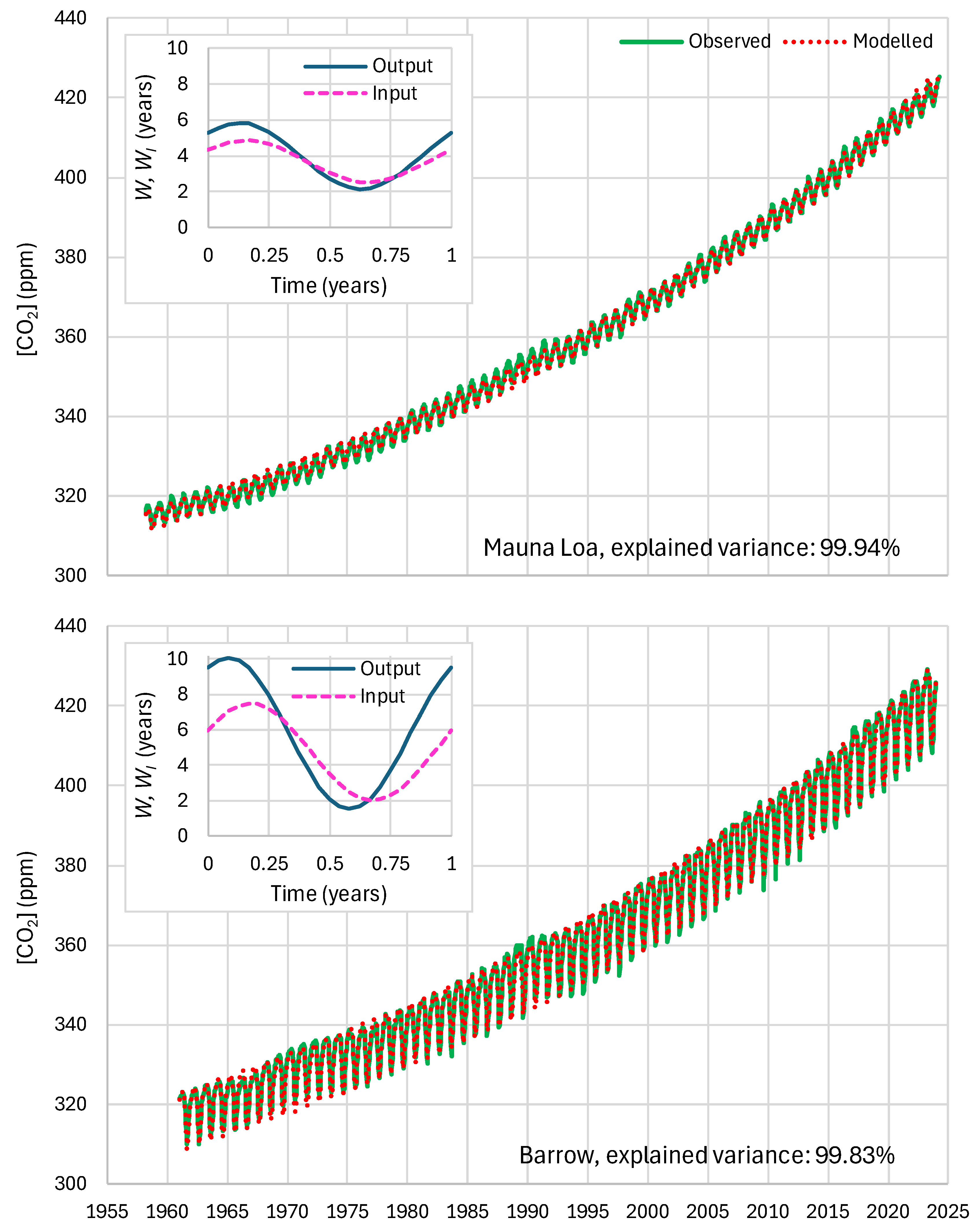
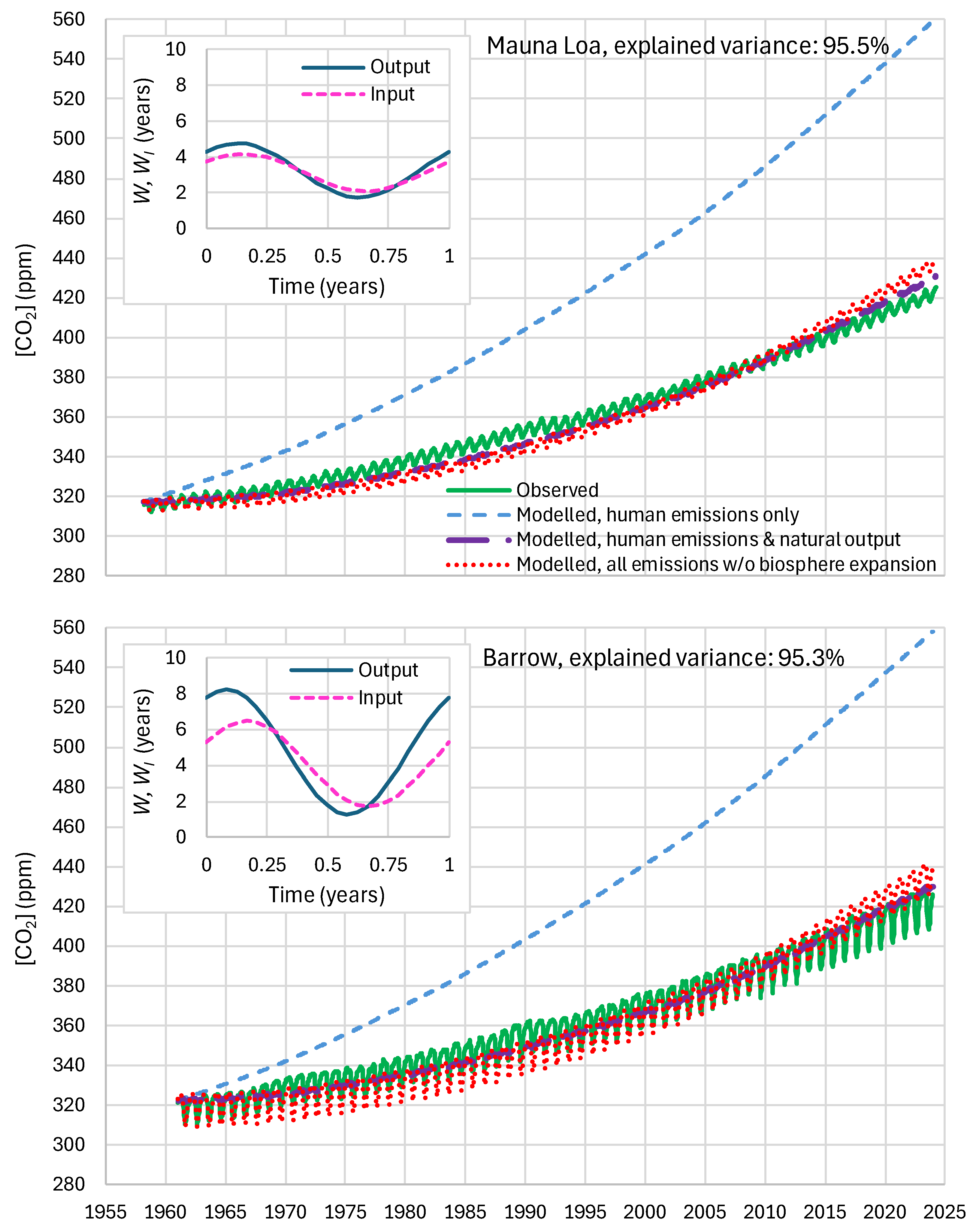
3.7 Residence Times
4. Discussion

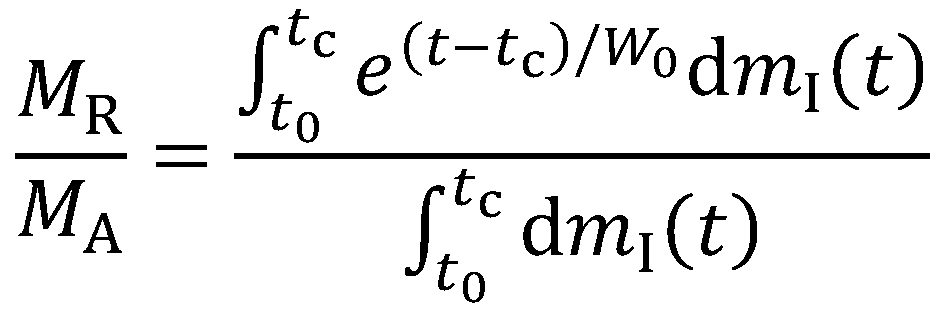
- The probability that a molecule remains after 1000 years is , where we have used Equation (29) to evaluate the .
- The probability that out of molecules none remains after 1000 years is and the probability that at least one molecule remains is . Given that as , , for small (as in our case), we have .
- According to IPCC [27 (Figure 5.12)] the atmospheric CO₂ amounts to 850 Pg C = g C. Thus, the mass of CO₂ is g (where 44 and 12 are the molecular masses of CO₂ and C). The number of moles is .
- The Avogadro constant is and thus the number of CO₂ molecules in the atmosphere is .
- Hence, the probability that, after 1000 years, at least one out of the molecules remains in the atmosphere is .
- A probability is almost an impossibility. Hence, we can be certain that none of the molecules existing in the atmosphere now, whether due to “emitted CO₂ pulse” or existing before it, will remain after 1000 years—let alone after “ten thousand years” or after “several hundred thousand years”.
- To make this probability a reasonable rarity of 1% () we need to make . This would occur at time such that , which yields years.
5. Conclusions
Supplementary Materials
Author Contributions
Funding
Data Availability Statement
Acknowledgments
Conflicts of Interest
Appendix A.1: Alternative approximations of a sublinear or superlinear reservoir
Appendix A.2: Notes on the Sum of Exponential Functions as a Response Function
| Term | ||||
| 0.2173 | 0.224 | 0.2824 | 0.2763 | |
| (years) | ∞ | 394.4 | 36.54 | 4.304 |
References
- Stendhal [penname of Henri Marie Beyle]. The Life of Henry Brulard [Vie de Henry Brulard, translated to English by J. Sturrock], ISBN 978-1-681371-22-1, The New York Review of Books, New York, NY, USA, 1995. Available online, https://archive.org/details/stendhal-life-of-henry-brulard/ (accessed on 30 April 2024).
- Müller-Neuhof, B.; Betts, A.V.G.; Wilcox, G. Jawa, Northeastern Jordan: the first 14C dates for the early occupation phase. Zeitschrift für Orient-Archäologie 2015, 8, 124–131. [Google Scholar]
- Fahlbusch, H. Early dams. Proceedings of the ICE - Engineering History and Heritage 2009, 162, 13–18. [Google Scholar] [CrossRef]
- Makarewicz, C.A.; Finlayson, B. Constructing community in the Neolithic of southern Jordan: Quotidian practice in communal architecture. PLOS ONE 2018, 13(6), e0193712. [Google Scholar] [CrossRef]
- Bible, Genesis , 41, https://www.bible.com/el/bible/2503/GEN.41.GRCBRENT?parallel=392. (accessed on 30 April 2024).
- Bell, B. Climate and the History of Egypt: The Middle Kingdom. American Journal of Archaeology 1975, 79, 223–269. [Google Scholar] [CrossRef]
- Said, R. The River Nile: Geology, Hydrology and Utilization; Pergamon Press: Oxford, UK, 1993. [Google Scholar]
- Hurst, H.E. Long term storage capacities of reservoirs. Trans. Am. Soc. Civil Eng. 1951, 116, 776–808. [Google Scholar] [CrossRef]
- Mandelbrot, B.B.; Wallis, J.R. Noah, Joseph, and operational hydrology. Water Resources Research 1968, 4(5), 909–918. [Google Scholar] [CrossRef]
- Koutsoyiannis, D. Stochastics of Hydroclimatic Extremes - A Cool Look at Risk, Edition 3, ISBN: 978-618-85370-0-2, 391 pp., Kallipos Open Academic Editions, Athens, 2023. [CrossRef]
- Klemeš, V. Watershed as semiinfinite storage reservoir. Journal of the Irrigation and Drainage Division 1973, 99(4), 477–491. [Google Scholar] [CrossRef]
- Liu, Z.; Todini, E. Assessing the TOPKAPI non-linear reservoir cascade approximation by means of a characteristic lines solution. Hydrological Processes 2005, 19, 1983–2006. [Google Scholar] [CrossRef]
- Fenicia, F.; Savenije, H.H.G.; Matgen, P.; Pfister, L. Is the groundwater reservoir linear? Learning from data in hydrological modelling, Hydrol. Earth Syst. Sci. 2006, 10, 139–150. [Google Scholar] [CrossRef]
- Koutsoyiannis, D. Revisiting the global hydrological cycle: is it intensifying? Hydrol. Earth Syst. Sci. 2020, 24, 3899–3932. [Google Scholar] [CrossRef]
- Nash, J.E.; Farrel, J.P. A graphical solution of the flood-routing equation for linear storage-discharge relation. Eos, Transactions American Geophysical Union 1955, 36, 319–320. [Google Scholar]
- Langbein, W.B. Queuing theory and water storage. Journal of the Hydraulics Division 1958, 84, 1–24. [Google Scholar] [CrossRef]
- Nash, J.E. Systematic determination of unit hydrograph parameters. Journal of Geophysical Research 1959, 64, 111–115. [Google Scholar] [CrossRef]
- Dooge, J. Linear Theory of Hydrologic Systems. (No. 1468) Agricultural Research Service, US Department of Agriculture, Washington DC, 1973, https://books.google.com/books?id=iVgTfUhBi2gC (accessed on 20 April 2024).
- Klemeš, V. Probability distribution of outflow from a linear reservoir. Journal of Hydrology 1974, 21, 305–314. [Google Scholar] [CrossRef]
- Klemeš, V.; Borůvka, L. Output from a cascade of discrete linear reservoirs with stochastic input. Journal of Hydrology 1975, 27, 1–13. [Google Scholar] [CrossRef]
- Basha, H.A. Nonlinear reservoir routing: particular analytical solution. Journal of Hydraulic Engineering 1994, 120(5), 624–632. [Google Scholar] [CrossRef]
- Paik, K. Analytical derivation of reservoir routing and hydrological risk evaluation of detention basins. Journal of Hydrology 2008, 352, 191–201. [Google Scholar] [CrossRef]
- Nematollahi, B.; Niazkar, M.; Talebbeydokhti, N. Analytical and numerical solutions to level pool routing equations for simplified shapes of inflow hydrographs. Iranian Journal of Science and Technology, Transactions of Civil Engineering 2021, 1–15. [Google Scholar]
- Basha, H.A. Routing equations for detention reservoirs. Journal of Hydraulic Engineering 1995, 121, 885–888. [Google Scholar] [CrossRef]
- Berry, E.X. Human CO2 emissions have little effect on atmospheric CO2. International Journal of Atmospheric and Oceanic Sciences 2019, 3, 13–26. [Google Scholar] [CrossRef]
- IPCC. Climate Change 2013: The Physical Science Basis. Contribution of Working Group I to the Fifth Assessment Report of the Intergovernmental Panel on Climate Change [Stocker, T.F., Qin, D., Plattner, G.-K., Tignor, M., Allen, S.K., Boschung, J., Nauels, A., Xia, Y., Bex V., Midgley, P.M., Eds.]. Cambridge University Press, Cambridge, United Kingdom and New York, NY, USA, 1535 pp. 2013.
- IPCC. Climate Change 2021: The Physical Science Basis. Contribution of Working Group I to the Sixth Assessment Report of the Intergovernmental Panel on Climate Change [Masson-Delmotte, V., Zhai, P., Pirani, A., Connors, S.L., Péan, C., Berger, S., Caud, N., Chen, Y., Goldfarb, L., Gomis, M.I., Huang, M., Leitzell, K., Lonnoy, E., Matthews, J.B.R., Maycock, T.K., Waterfield, T., Yelekçi, O., Yu, R., Zhou, B. Eds.]. Cambridge University Press, Cambridge, United Kingdom and New York, NY, USA, 2391 pp., 2021. [CrossRef]
- Koutsoyiannis, D.; Onof, C.; Christofides, A.; Kundzewicz, Z.W. Revisiting causality using stochastics: 1. Theory. Proc. R. Soc. A 2022, 478, 20210836. [Google Scholar] [CrossRef]
- Koutsoyiannis, D.; Onof, C.; Christofides, A.; Kundzewicz, Z.W. Revisiting causality using stochastics: 2. Applications, Proc. R. Soc. A, 2022, 478, 20210835. [Google Scholar] [CrossRef]
- Koutsoyiannis, D.; Onof, C.; Kundzewicz, Z.W.; Christofides, A. On Hens, Eggs, Temperatures and CO2: Causal Links in Earth’s Atmosphere. Sci 2023, 5, 35. [Google Scholar] [CrossRef]
- Salby, M.L. Physics of the Atmosphere and Climate; Cambridge University Press: New York, NY, USA, 2012. [Google Scholar]
- Humlum, O.; Stordahl, K.; Solheim, J.E. The phase relation between atmospheric carbon dioxide and global temperature. Global and Planetary Change 2013, 100, 51–69. [Google Scholar] [CrossRef]
- Harde, H. Scrutinizing the carbon cycle and CO2 residence time in the atmosphere. Global and Planetary Change 2017, 152, 19–26. [Google Scholar] [CrossRef]
- Harde, H. What humans contribute to atmospheric CO2: Comparison of carbon cycle models with observations. Earth Sciences 2019, 8, 139–159. [Google Scholar] [CrossRef]
- Poyet, P. The Rational Climate e-Book. 2nd Edition, ISBN: 978-99957-1-929-62022, Available online, https://www.researchgate.net/publication/347150306 (accessed on 30 April 2024).
- Stallinga, P. Residence time vs. adjustment time of carbon dioxide in the atmosphere. Entropy 2023, 25, 384. [Google Scholar] [CrossRef] [PubMed]
- Joos, F.; Roth, R.; Fuglestvedt, J.S.; Peters, G.P.; Enting, I.G.; von Bloh, W.; Brovkin, V.; Burke, E.J.; Eby, M.; Edwards, N.R.; Friedrich, T.; Frölicher, T.L.; Halloran, P.R.; Holden, P.B.; Jones, C.; Kleinen, T.; Mackenzie, F.T.; Matsumoto, K.; Meinshausen, M.; Plattner, G.-K.; Reisinger, A.; Segschneider, J.; Shaffer, G.; Steinacher, M.; Strassmann, K.; Tanaka, K.; Timmermann, A.; Weaver, A.J. Carbon dioxide and climate impulse response functions for the computation of greenhouse gas metrics: a multi-model analysis. Atmos. Chem. Phys. 2013, 13, 2793–2825. [Google Scholar] [CrossRef]
- Joos, F.; Bruno, M.; Fink, R.; Siegenthaler, U.; Stocker, T.F.; Le Quere, C.; Sarmiento, J.L. An efficient and accurate representation of complex oceanic and biospheric models of anthropogenic carbon uptake. Tellus B 1996, 48, 397–417. [Google Scholar] [CrossRef]
- Archer, D.; Brovkin, V. The millennial atmospheric lifetime of anthropogenic CO2. Climatic Change 2008, 90, 283–297. [Google Scholar] [CrossRef]
- Archer, D.; Eby, M.; Brovkin, V.; Ridgwell, A.; Cao, L.; Mikolajewicz, U.; Caldeira, K.; Matsumoto, K.; Munhoven, G.; Montenegro, A.; Tokos, K. ,. Atmospheric lifetime of fossil fuel carbon dioxide. Annual Review of Earth and Planetary Sciences 2009, 37, 117–134. [Google Scholar] [CrossRef]
- MIT Climate Portal Writing Team featuring guest expert Ed Boyle, How Do We Know How Long Carbon Dioxide Remains in the Atmosphere? MIT Climate Portal, 2023. Available online, https://climate.mit.edu/ask-mit/how-do-we-know-how-long-carbon-dioxide-remains-atmosphere (accessed on 30 April 2024).
- Buis, A. The Atmosphere: Getting a Handle on Carbon Dioxide, NASA's Jet Propulsion Laboratory, 2019. Available online, https://science.nasa.gov/earth/climate-change/greenhouse-gases/the-atmosphere-getting-a-handle-on-carbon-dioxide/ (accessed on 30 April 2024).
- Berry, E. Why Climate Change Is a Fraud, Available online, https://edberry.com/why-climate-change-is-a-fraud/ (accessed on 30 April 2024).
- Myhre, G.; Shindell, D.; Bréon, F.-M.; Collins, W.; Fuglestvedt, J.; Huang, J.; Koch, D.; Lamarque, J.-F.; Lee, D.; Mendoza, B.; Nakajima, T.; Robock, A.; Stephens, G.; Takemura, T.; Zhang H. Anthropogenic and natural radiative forcing supplementary material. In: Climate Change 2013: The Physical Science Basis. Contribution of Working Group I to the Fifth Assessment Report of the Intergovernmental Panel on Climate Change [Stocker, T.F., Qin, D., Plattner, G.-K., Tignor, M., Allen, S.K., Boschung, J., Nauels, A., Xia, Y., Bex V., Midgley, P.M., Eds.]. Cambridge University Press, Cambridge, United Kingdom and New York, NY, USA, 1535 pp. 2013. Available from https://www.ipcc.ch/report/ar5/wg1/chapter-8sm-anthropogenic-and-natural-radiative-forcing-supplementary-material/ (accessed on 30 April 2024).
- Strassmann, K.M.; Joos, F. The Bern Simple Climate Model (BernSCM) v1.0: an extensible and fully documented open-source re-implementation of the Bern reduced-form model for global carbon cycle–climate simulations. Geosci. Model Dev. 2018, 11, 1887–1908. [Google Scholar] [CrossRef]
- Luo, X.; Xia, T.; Huang, J.; Xiong, D.; Ridoutt, B. Radiative forcing climate footprints in the agricultural sector: Comparison of models from the IPCC 5th and 6th Assessment Reports. Farming System 2023, 1, 100057. [Google Scholar] [CrossRef]
- Keeling, C.D.; Piper, S.C.; Whorf, T.P.; Keeling, R.F. Evolution of natural and anthropogenic fluxes of atmospheric CO2 from 1957 to 2003. Tellus B: Chemical and Physical Meteorology 2011, 63, 1–22. [Google Scholar] [CrossRef]
- Scripps CO2 Program, Sampling Station Records, Available online, https://scrippsco2.ucsd.edu/data/atmospheric_co2/sampling_stations.html (accessed on 30 April 2024).
- Keeling, C.D.; Piper, S.C.; Bacastow, R.B.; Wahlen, M;. Whorf, T.P.; Heimann, M.; Meijer, H.A. Exchanges of atmospheric CO2 and 13CO2 with the terrestrial biosphere and oceans from 1978 to 2000. I. Global aspects, SIO Reference Series, No. 01-06, Scripps Institution of Oceanography, San Diego, 88 pp., 2001.
- Keeling, C.D.; Piper, S.C.; Bacastow, R.B.; Wahlen, M;. Whorf, T.P.; Heimann, M.; Meijer, H.A. Atmospheric CO2 and 13CO2 exchange with the terrestrial biosphere and oceans from 1978 to 2000: observations and carbon cycle implications. In A History of Atmospheric CO2 and its effects on Plants, eds, Ehleringer, J.R.; Cerling, T.E.; Dearing, M.D., 83-113, Springer Verlag, New York, 2005.
- Ritchie, H.; Roser, M. CO₂ emissions. OurWorldInData.org, 2020. Available online, https://ourworldindata.org/co2-emissions (accessed on 30 April 2024).
- Global Carbon Budget (2023) – with major processing by Our World in Data. “Annual CO₂ emissions – GCB” [dataset]. Global Carbon Project, “Global Carbon Budget” [original data]. Available online, https://ourworldindata.org/co2-and-greenhouse-gas-emissions (accessed on 30 April 2024).
- International Energy Agency. CO2 Emissions in 2023, 2024. Available online, https://iea.blob.core.windows.net/assets/33e2badc-b839-4c18-84ce-f6387b3c008f/CO2Emissionsin2023.pdf (accessed on 30 April 2024).
- Koutsoyiannis, D.; Kundzewicz, Z.W. Atmospheric temperature and CO2: hen-or-egg causality? Sci 2020, 2, 83. [Google Scholar] [CrossRef]
- Patel, K.F.; Bond-Lamberty, B.; Jian, J. l Morris, K.A.; McKever, S.A.; Norris, C.G.; Zheng, J.; Bailey, V.L.. Carbon flux estimates are sensitive to data source: a comparison of field and lab temperature sensitivity data. Environmental Research Letters 2022, 17, 113003. [Google Scholar] [CrossRef]
- Robinson, C. Microbial respiration, the engine of ocean deoxygenation. Frontiers in Marine Science 2019, 5, 533. [Google Scholar] [CrossRef]
- Granger, C.W. Investigating causal relations by econometric models and cross-spectral methods. Econometrica 1969, 37, 424–438. [Google Scholar] [CrossRef]
- Koutsoyiannis, D.; Vournas, C. Revisiting the greenhouse effect—a hydrological perspective. Hydrological Sciences Journal 2024, 69, 151–164. [Google Scholar] [CrossRef]
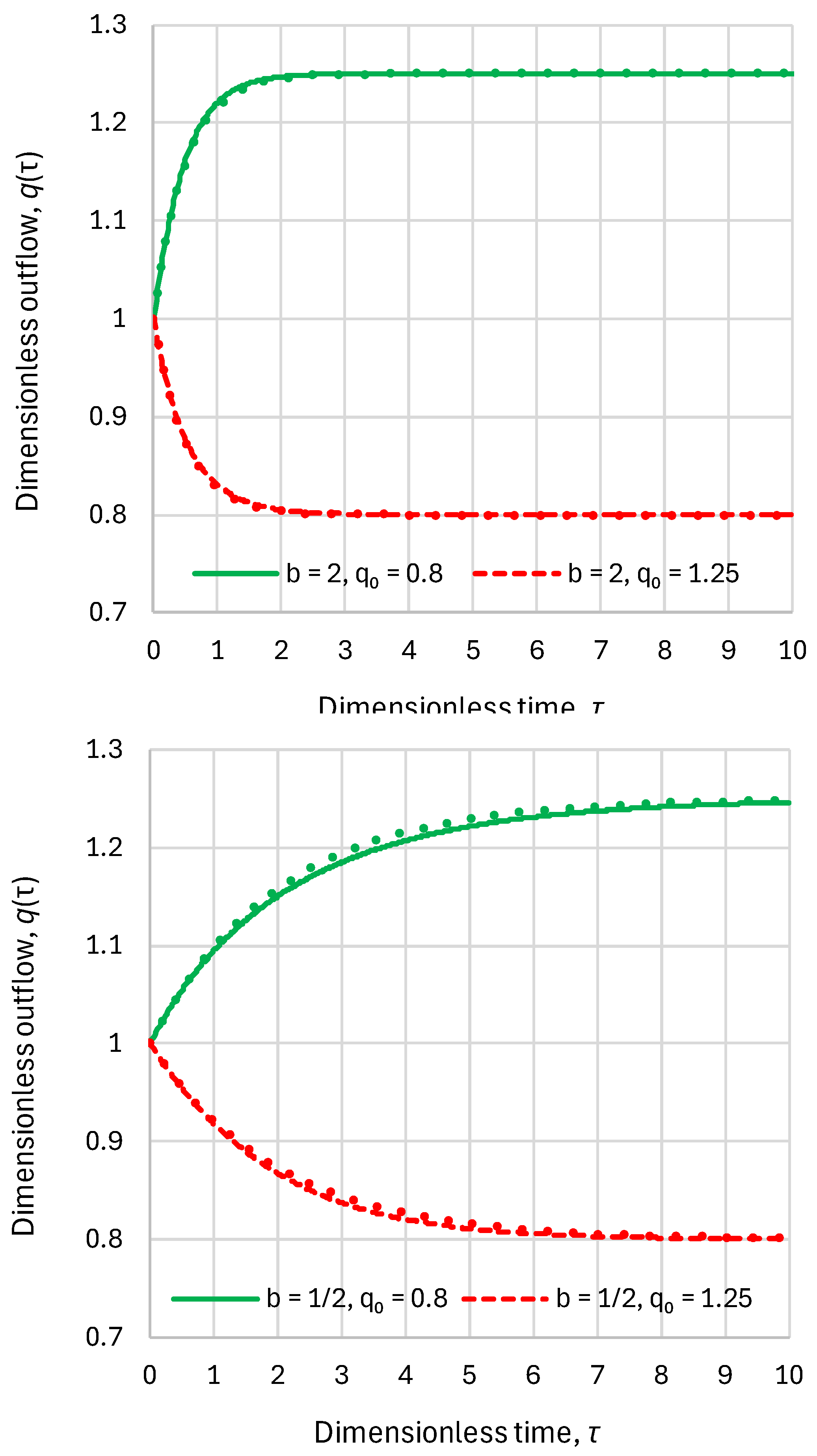
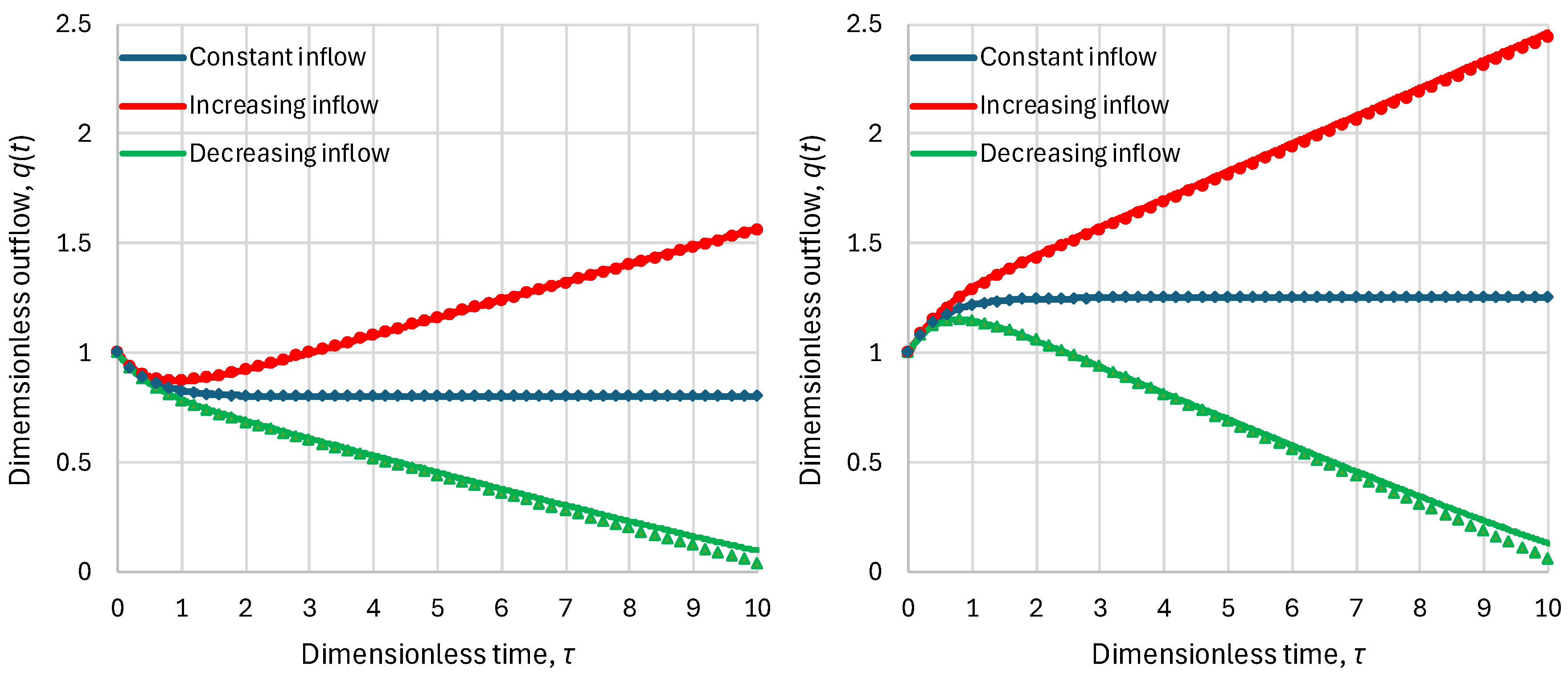
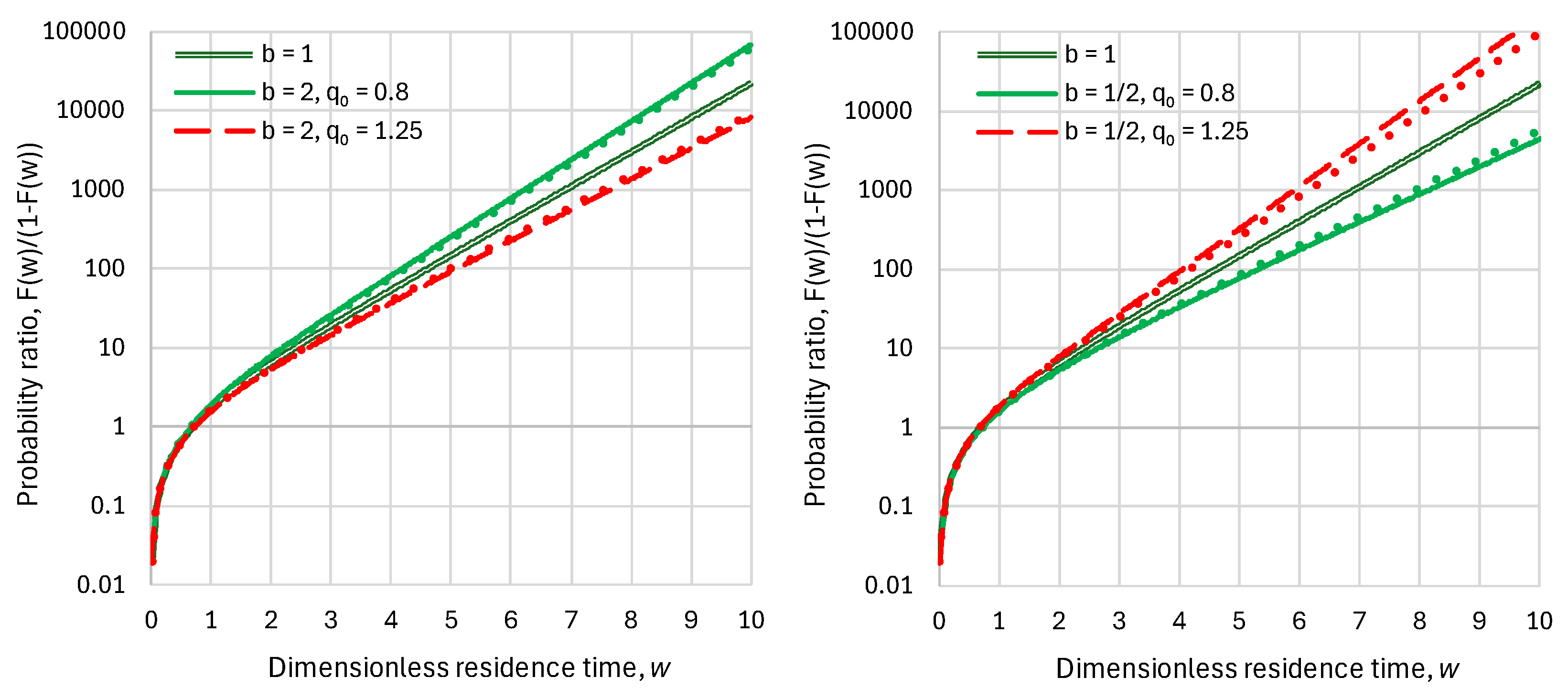
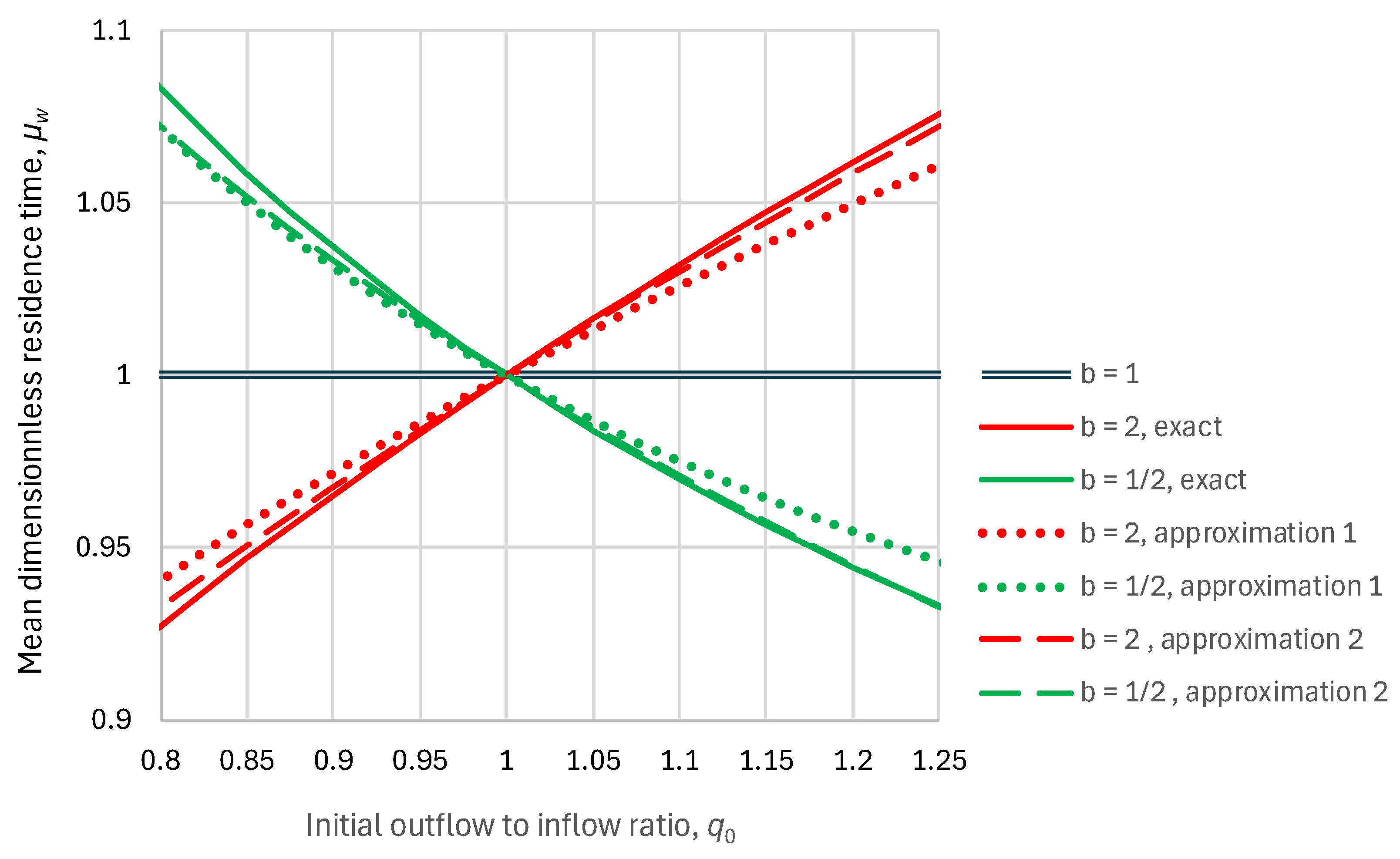

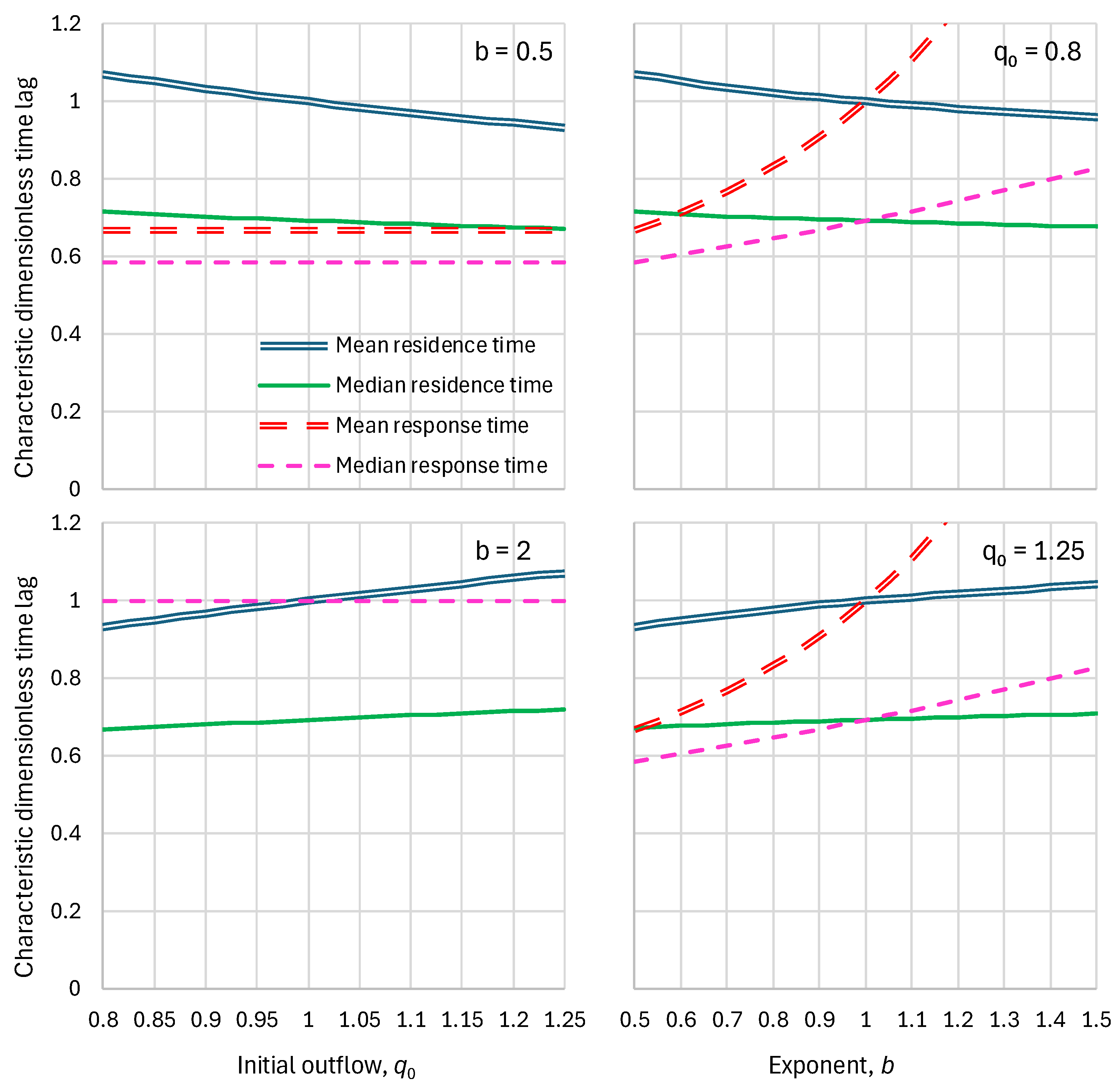
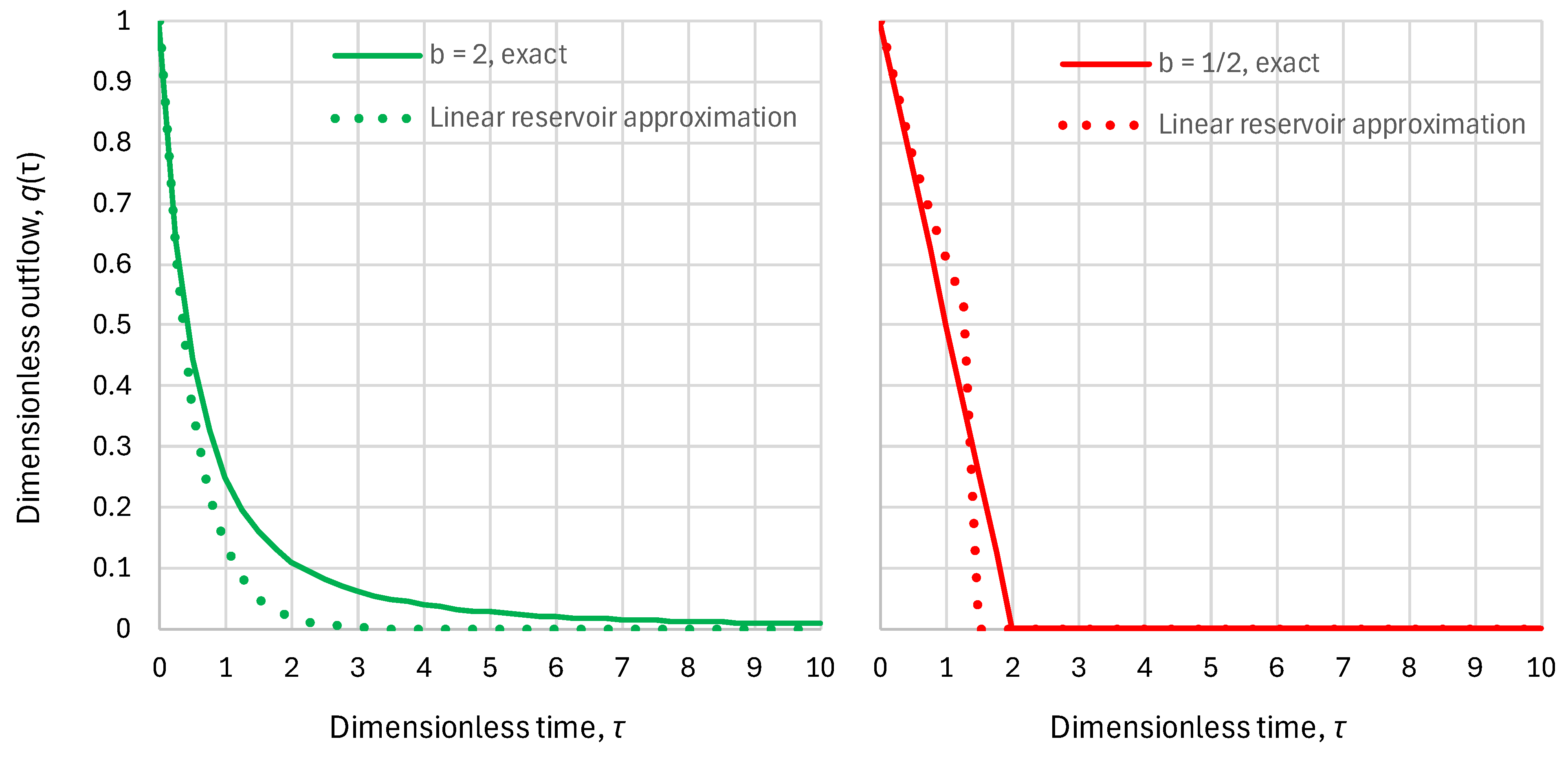
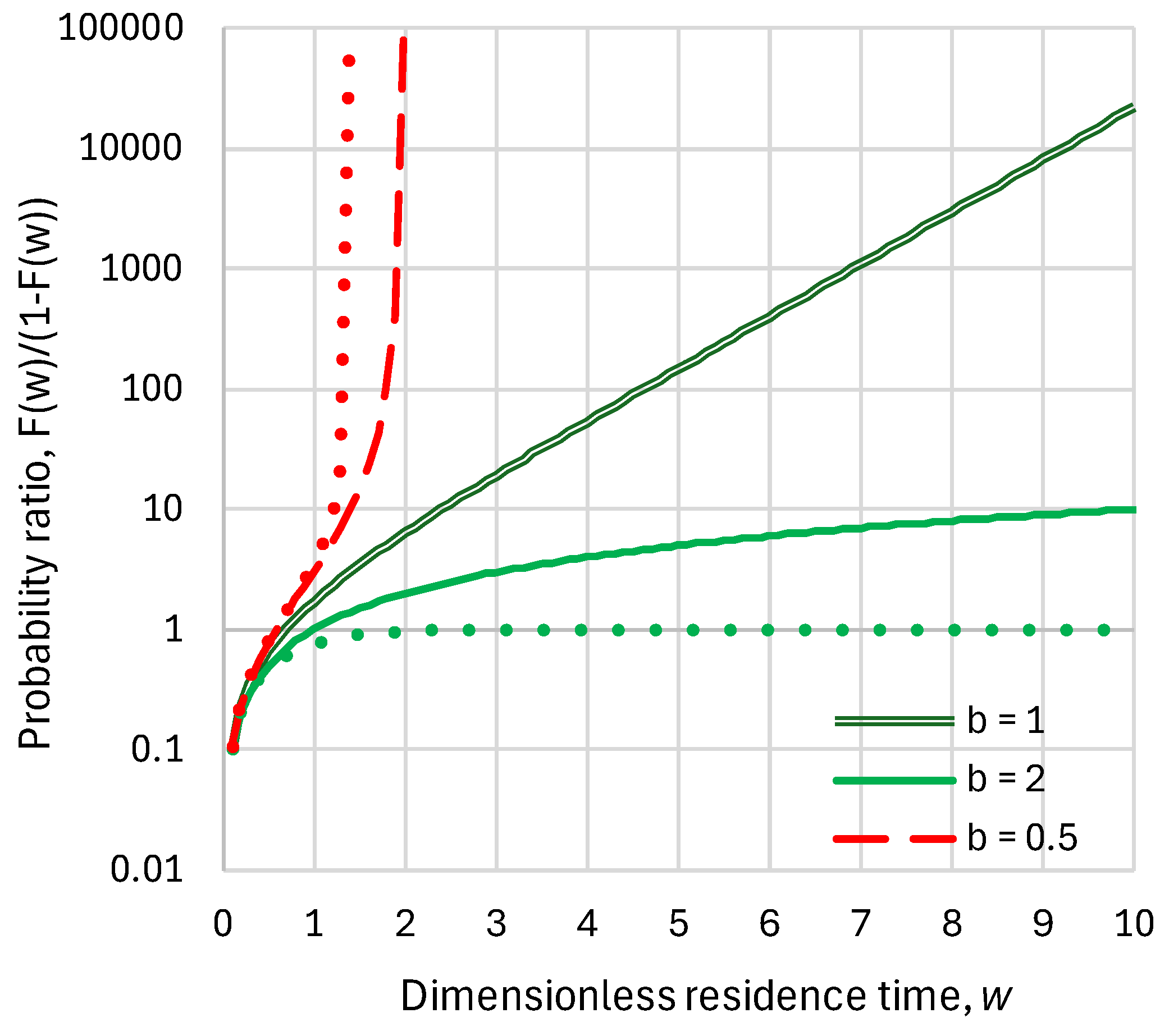
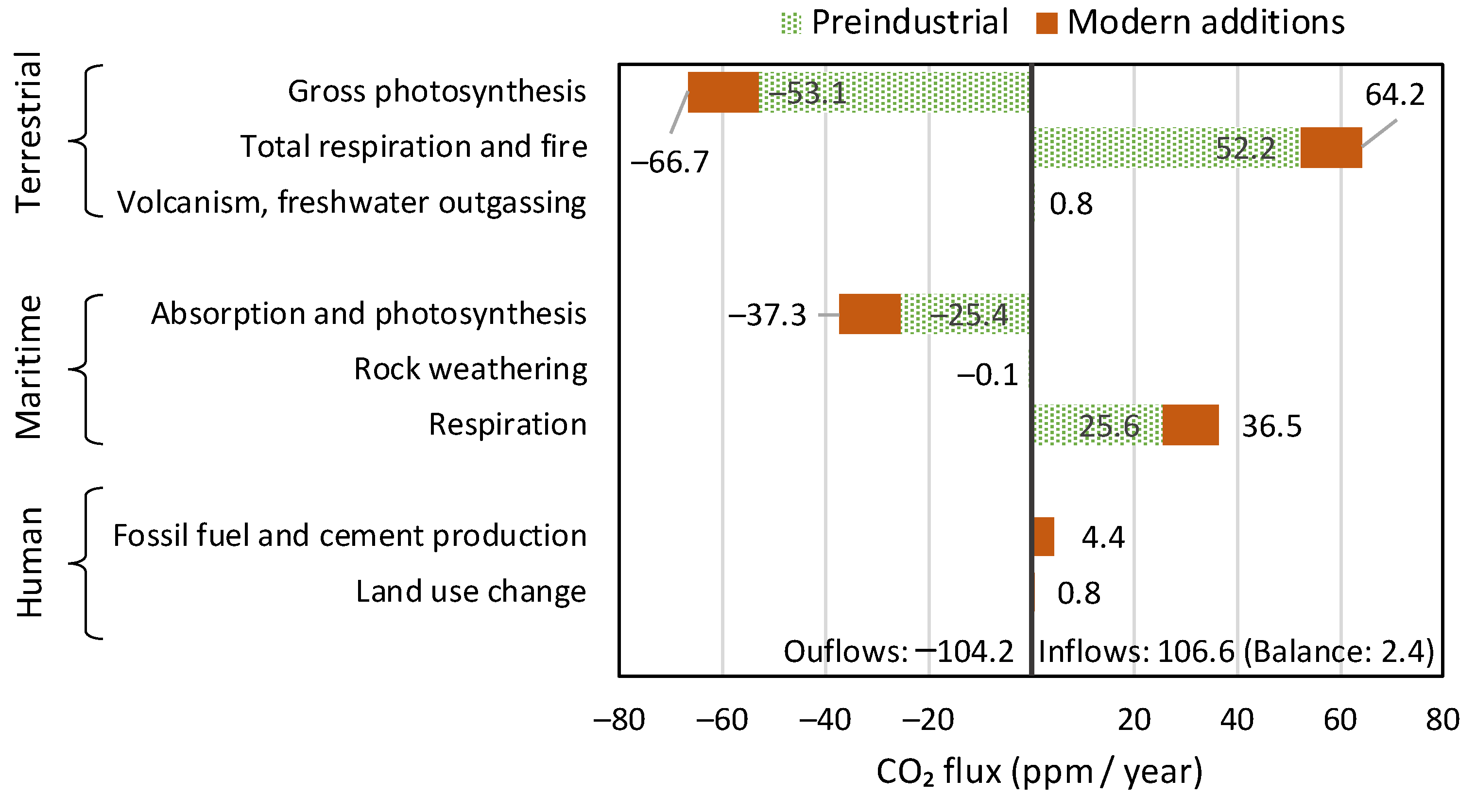
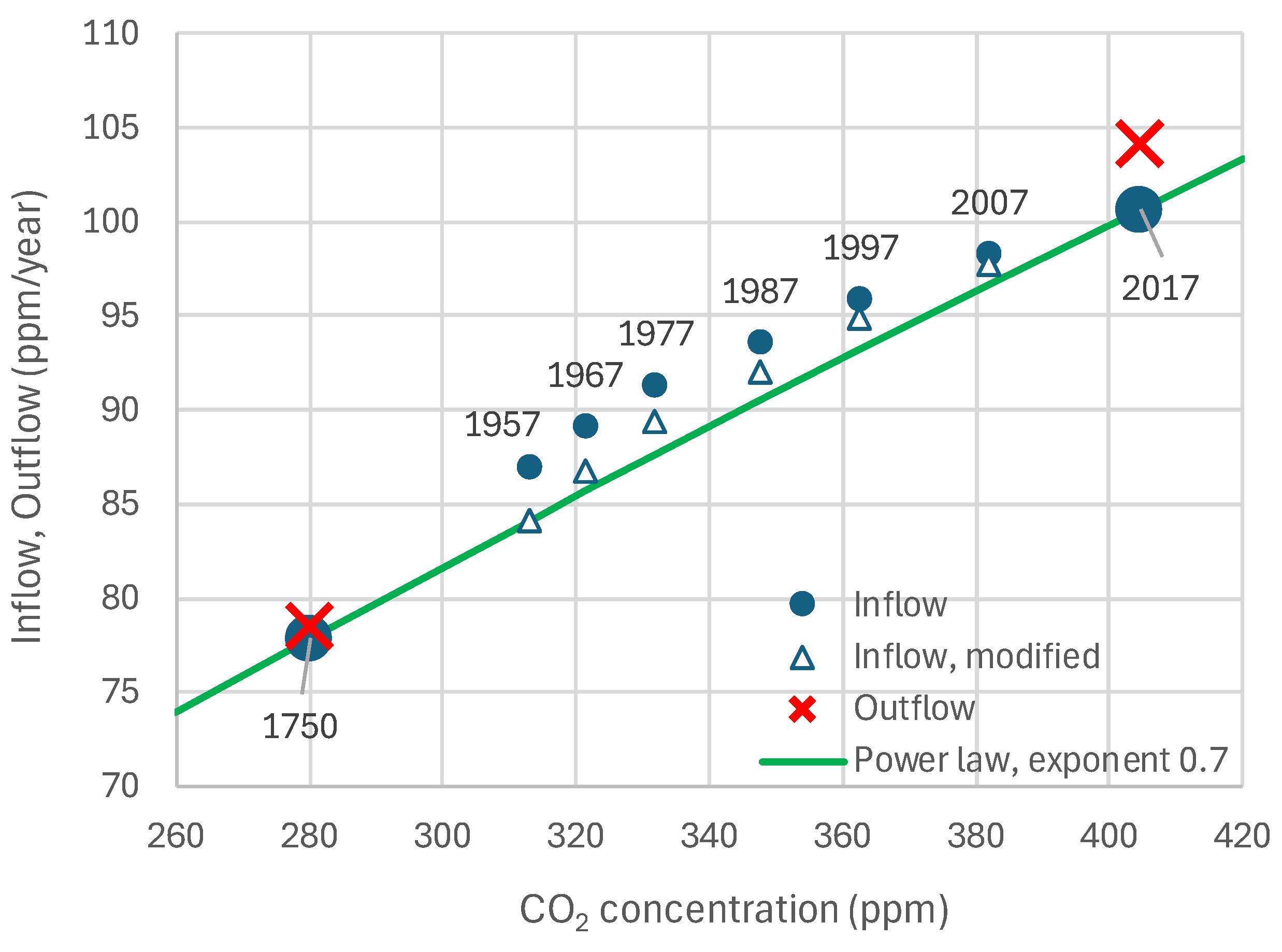

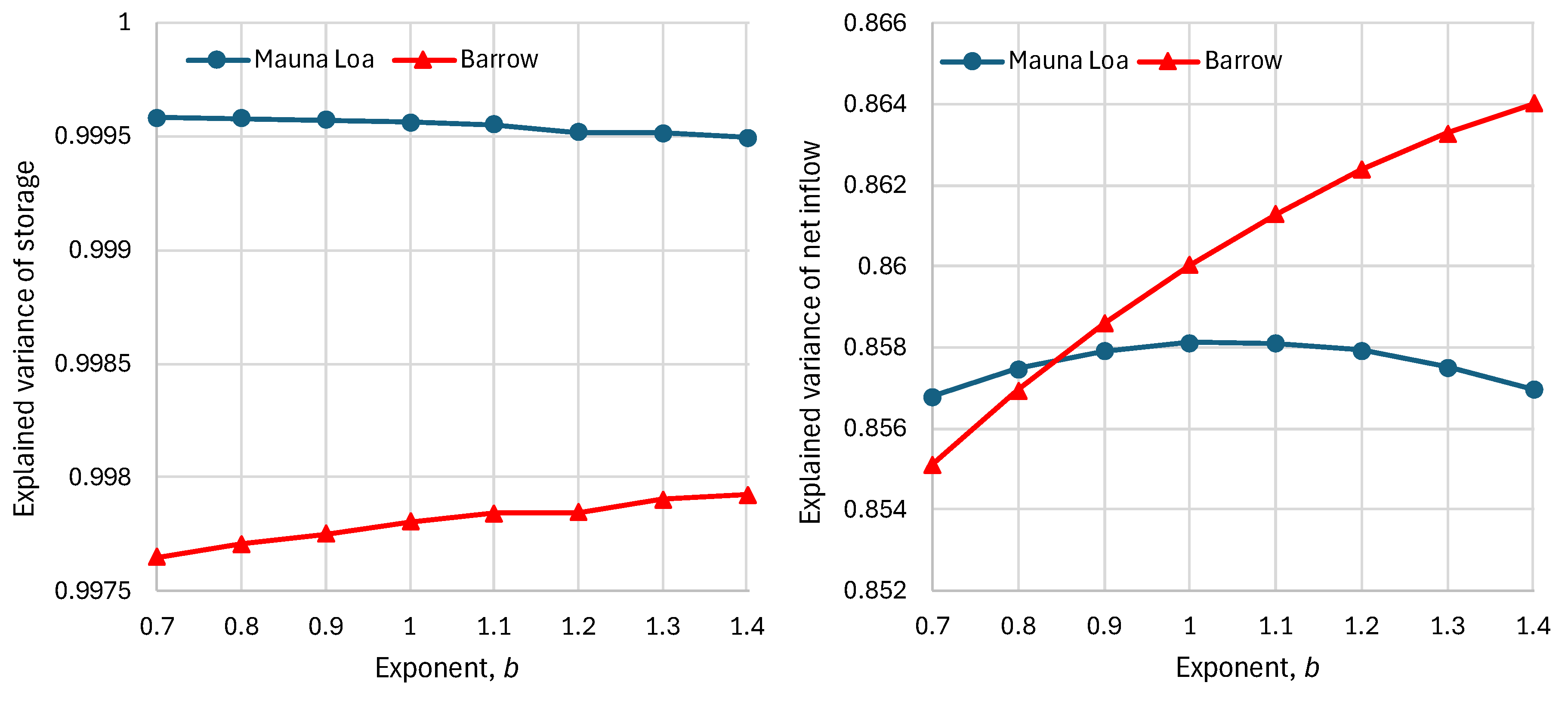
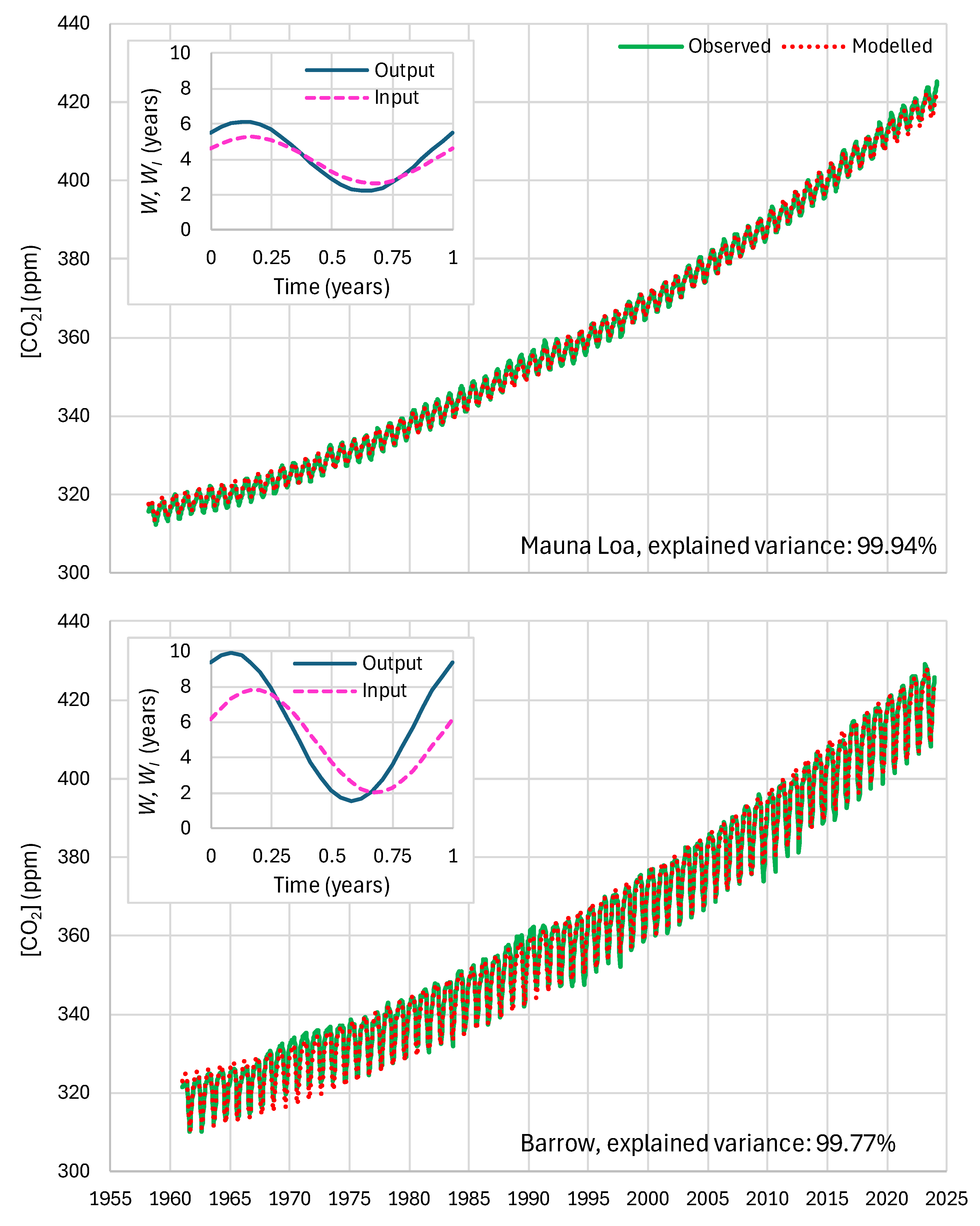
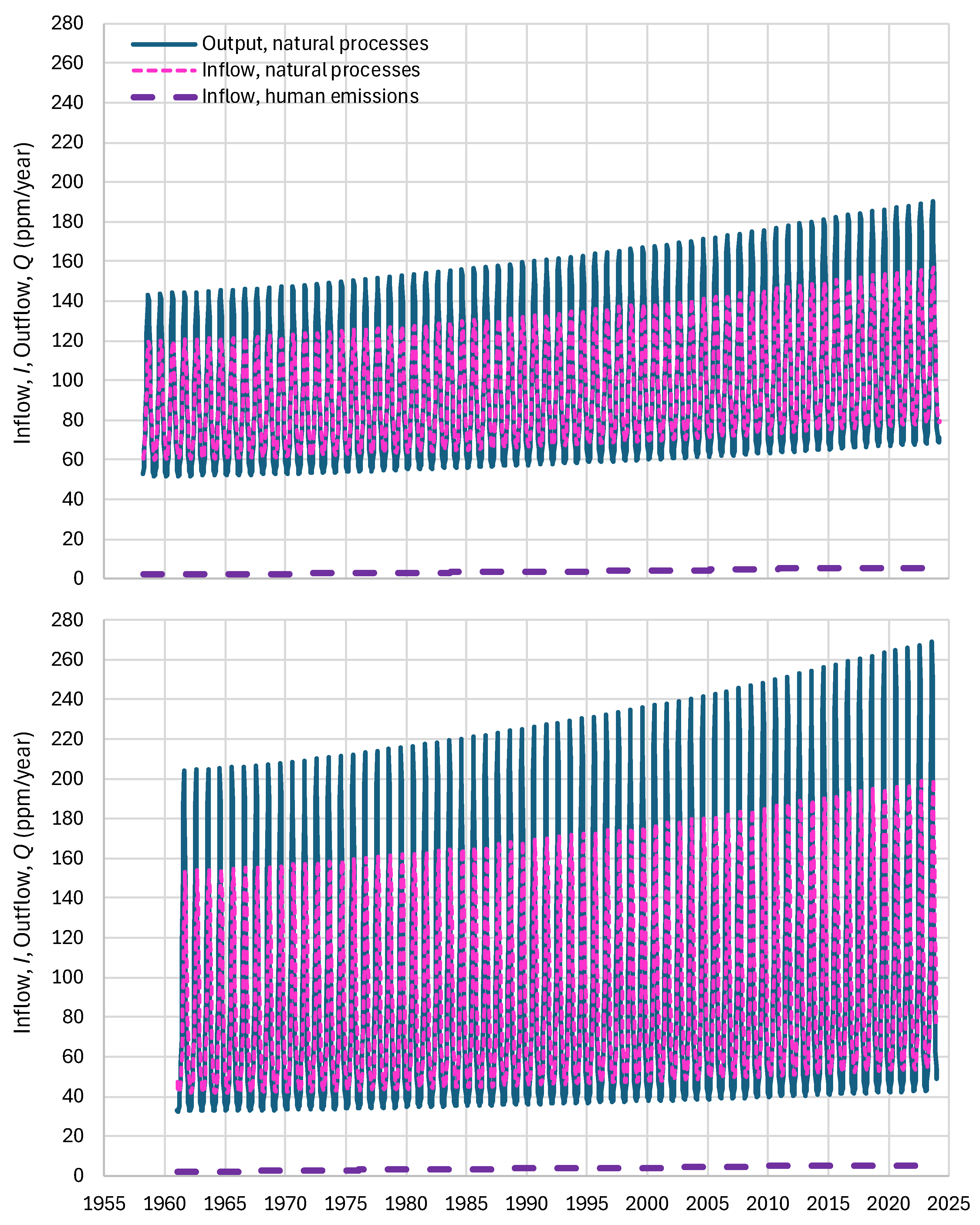
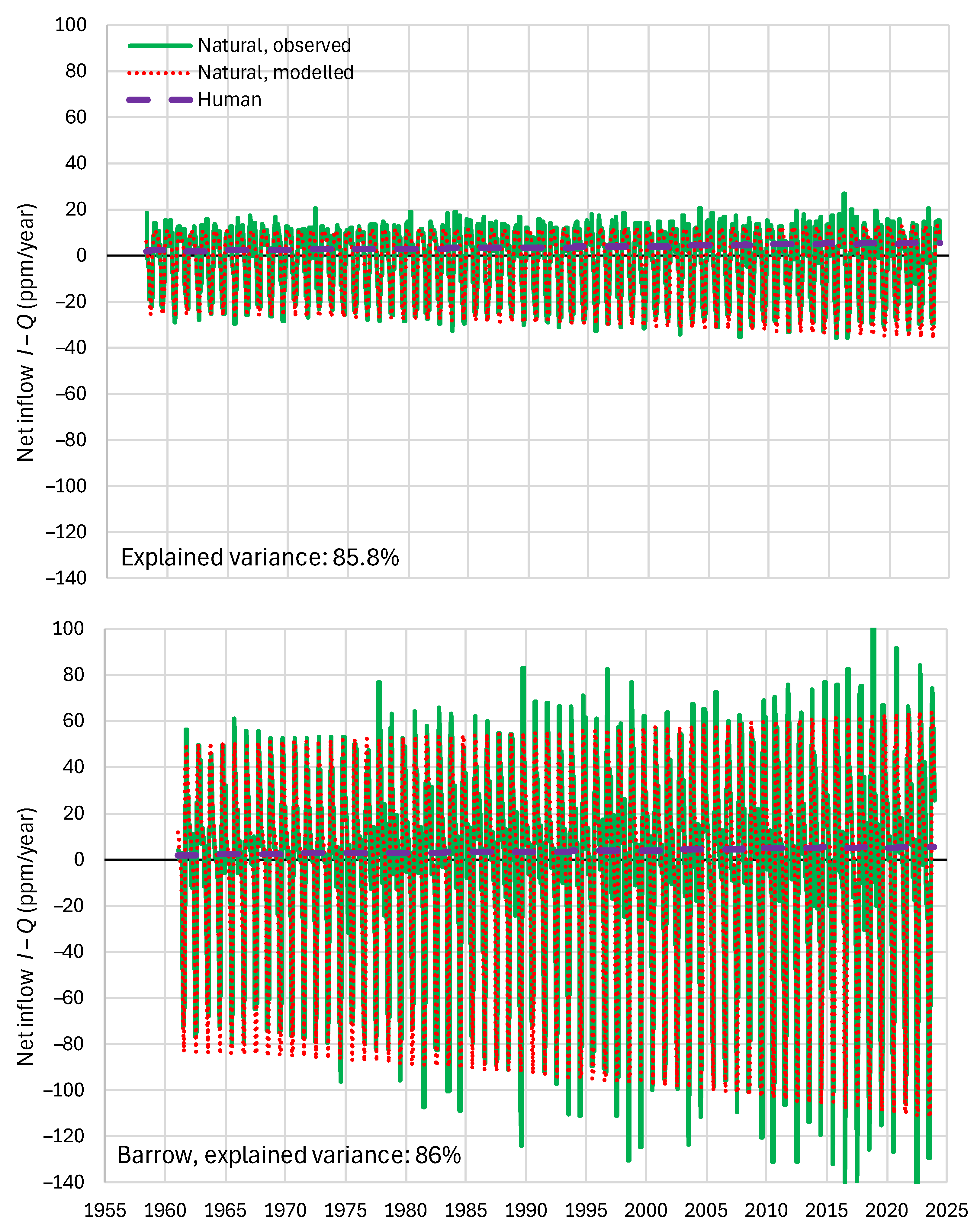
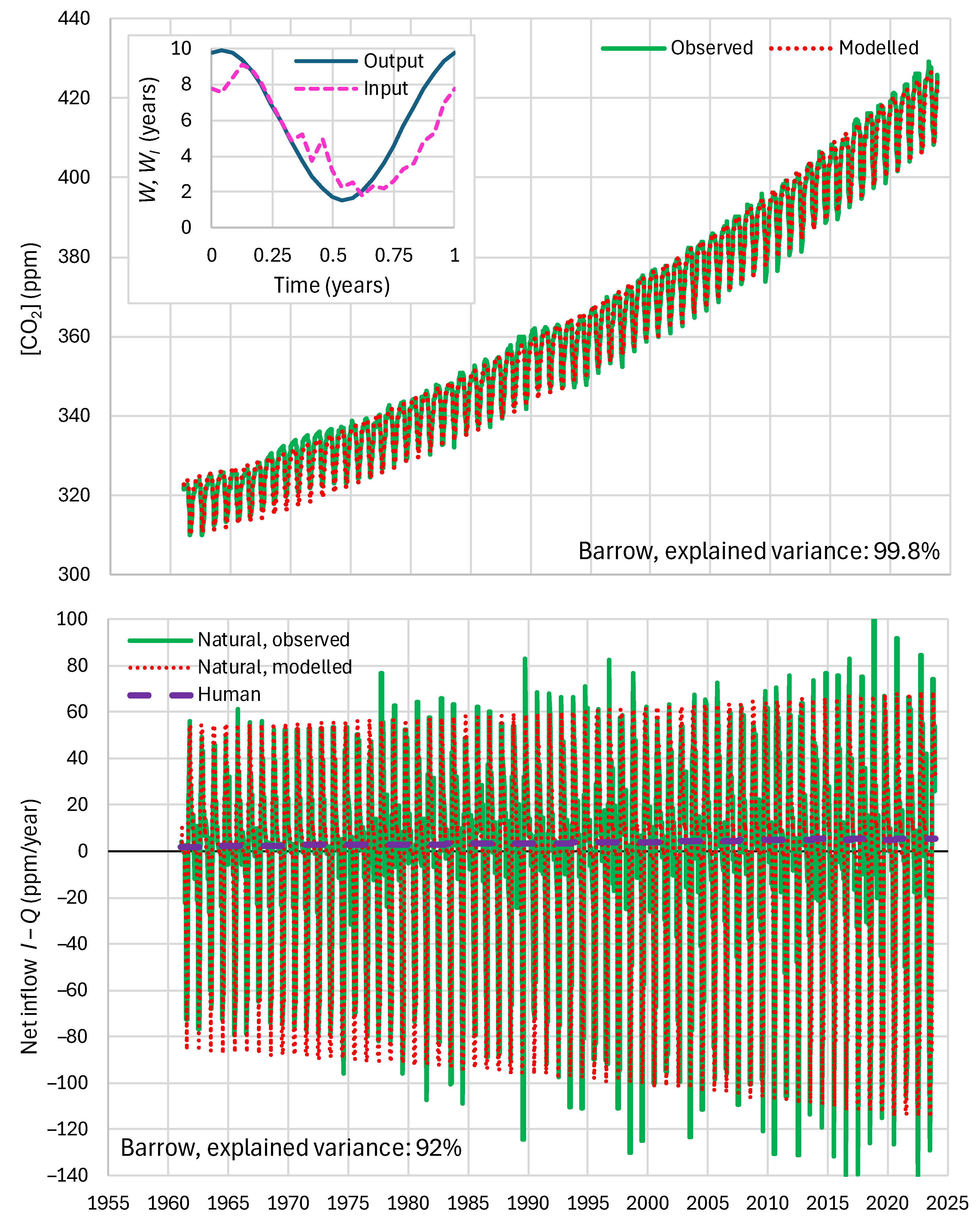
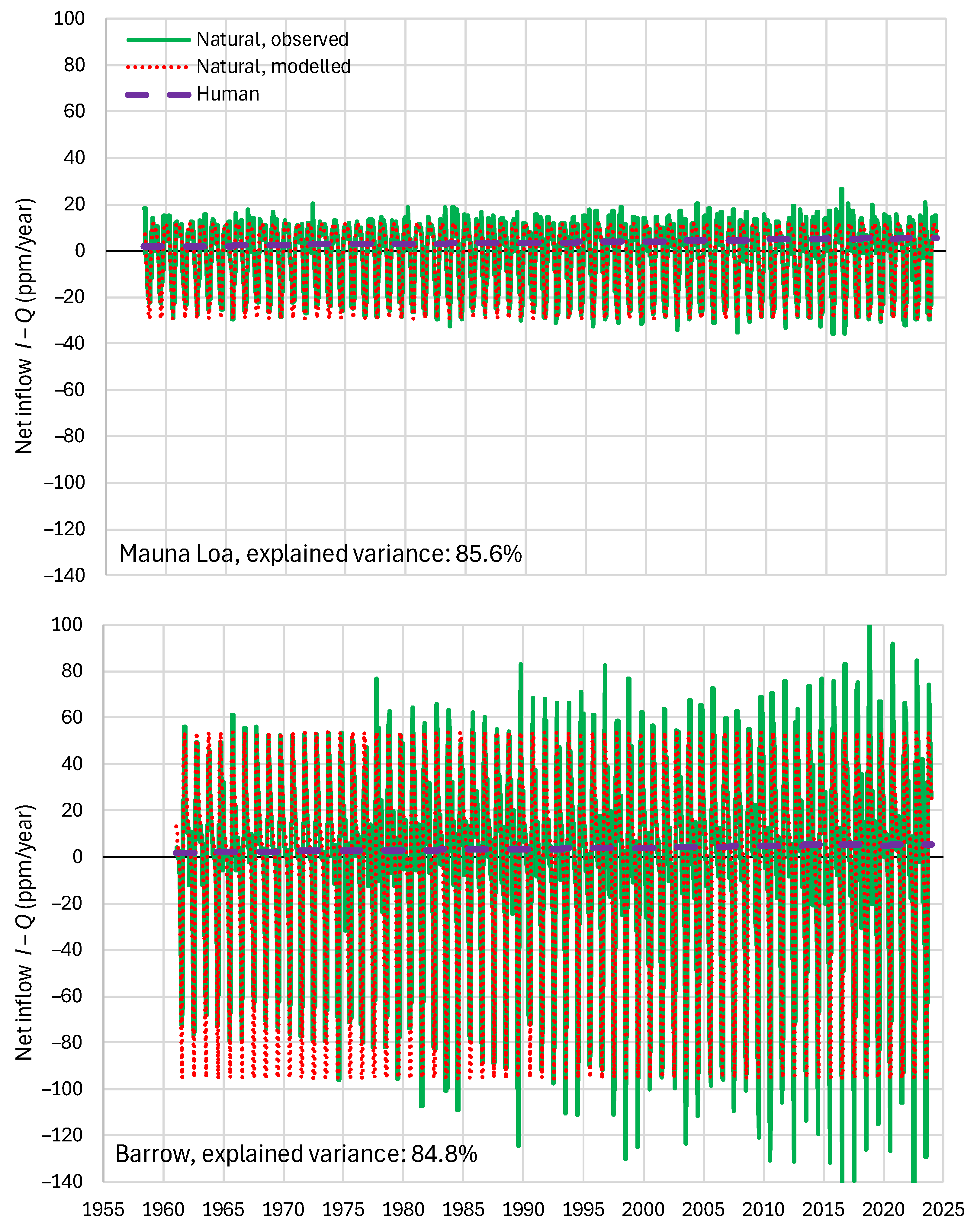
| Site | (years) | (years) | ||||||
|---|---|---|---|---|---|---|---|---|
| Mauna Loa | 1 | 5.448 | 1.964 | 2.117 | 0.945 | 5.253 | 1.454 | 2.858 |
| Barrow | 1 | 5.758 | 4.182 | 1.369 | 0.945 | 5.151 | 3.081 | 1.633 |
| Site | , beginning year | , ending year | ||||
|---|---|---|---|---|---|---|
| Mauna Loa | 2.21 | 6.13 | 4.17 | 3.68 | 3.69 | 3.69 |
| Barrow | 1.55 | 9.90 | 5.72 | 3.91 | 3.95 | 3.95 |
Disclaimer/Publisher’s Note: The statements, opinions and data contained in all publications are solely those of the individual author(s) and contributor(s) and not of MDPI and/or the editor(s). MDPI and/or the editor(s) disclaim responsibility for any injury to people or property resulting from any ideas, methods, instructions or products referred to in the content. |
© 2024 by the authors. Licensee MDPI, Basel, Switzerland. This article is an open access article distributed under the terms and conditions of the Creative Commons Attribution (CC BY) license (http://creativecommons.org/licenses/by/4.0/).





